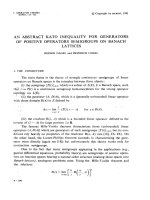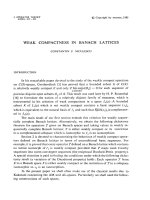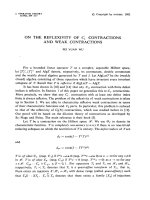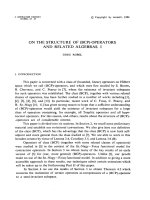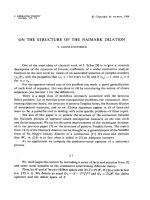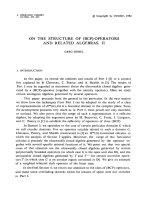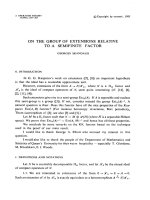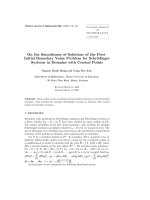Báo cáo toán học: " On the shadow of squashed" ppsx
Bạn đang xem bản rút gọn của tài liệu. Xem và tải ngay bản đầy đủ của tài liệu tại đây (93.54 KB, 8 trang )
On the shadow of squashed families of k-sets
Fr´ed´eric Maire
Neurocomputing Research Center
Queensland University of Technology
Box 2434 Brisbane Qld 4001, Australia
Abstract:
The shadow of a collection A of
k
-sets is defined as the collection of the
(
k
− 1)-sets which are contained in at least one
k
-set of A.Given|A|,thesizeof
the shadow is minimum when A is the family of the first
k
-sets in squashed order (by
definition, a
k
-set
A
is smaller than a
k
-set
B
in the squashed order if the largest
element of the symmetric difference of
A
and
B
is in
B
). We give a tight upper bound
and an asymptotic formula for the size of the shadow of squashed families of
k
-sets.
Submitted: January 15, 1995; Accepted: August 25, 1995.
AMS Subject Classification.
04A20,03E05,05A20.
1 Introduction
A hypergraph is a collection of subsets (called edges) of a finite set
S
. If a hypergraph
A is such that
A
i
,A
j
∈Aimplies
A
i
⊆
A
j
,thenA is called an antichain.Inother
words A is a collection of incomparable sets. Antichains are also known under the
names simple hypergraph or clutter.
The shadow of a collection A of
k
-sets (set of size
k
) is defined as the collection
of the (
k
− 1)-sets which are contained in at least one
k
-set of A. The shadow of A
is denoted by ∆(A).
In the following we assume that
S
is a set of integers. The squashed order is
defined on the the set of
k
-sets. Given two
k
-sets
A
and
B
,wesaythat
A
is smaller
than
B
in the squashed order if the largest element of the symmetric difference of
A
and
B
is in
B
. The first 3-sets in the squashed order are
{1
,
2
,
3}
,
{1
,
2
,
4}
,
{1
,
3
,
4}
,
{2
,
3
,
4}
,
{1
,
2
,
5}
,
{1
,
3
,
5}
,
···
Let
F
k
(
x
)denotethefamilyofthefirst
xk
-sets in the squashed order. We will
prove the following.
the electronic journal of combinatorics 2 (1995) #R16 2
Theorem 1 If x ≤
n
k
then
|∆(F
k
(x))|≤kx − x(x − 1) × q
n,k
where q
n,k
=
k
n
k
− 1
×
n − k
n − k +1
Equality holds when x =0or x =
n
k
.
Theorem 2 When x →∞, |∆(F
k
(x))|∼
k
k
√
k!
x
1−
1
k
The squashed order is very useful when dealing with the size of the shadow of a
collection of k-sets. The main result is that if you want to minimize the shadow then
you have to take the first sets in the squashed order. This is a consequence of the
Kruskal-Katona theorem [4, 3]. Before stating their theorem, recall the definition of
the l-binomial representation of a number.
Theorem 3 Given positive integers x and l, there exists a unique representation of
x (called the l-binomial representation) in the form
x =
x
l
l
+
x
l−1
l − 1
+ ···+
x
t
t
where x
l
>x
l−1
> ···>x
t
≥ t.
See [1] or [2] for more details.
Theorem 4 (Kruskal-Katona) Let A be a collection of l-sets, and suppose that
the l-binomial representation of |A| is
|A| =
x
l
l
+
x
l−1
l − 1
+ ···+
x
t
t
where x
l
>x
l−1
> ···>x
t
≥ t. Then
|∆(A)|≥
x
l
l − 1
+
x
l−1
l − 2
+ ···+
x
t
t − 1
There is equality when A is the collection of the first |A| l-sets in the squashed order.
Though the above theorem gives the exact values of the shadow when the an-
tichain is squashed, it is awkward to manipulate. Because of this, theorem 1 may be
more useful for some problems such as those of construction of completely separating
systems (see [5], for example).
the electronic journal of combinatorics 2 (1995) #R16 3
2Proofs
2.1 Proof of theorem 1
We need a few lemmas before proving theorem 1.
Lemma 1
The inequality of theorem 1 holds when n ≤ 6.
Proof of lemma 1:
Done by computer check. Can be done by hand too. ✷
Lemma 2
The inequality of theorem 1 holds when k =1.
Proof of lemma 2:
We have q
n,1
=1/n. So the inequality to prove is;
|∆(F
1
(x))|≤x − x(x − 1) ×
1
n
The right hand side of the inequality can be rewritten as
x
n
(n − x +1)
As |∆(F
1
(x))| is equal to 1 (because ∆(F
1
(x)) = {∅}), all we have to prove is that
n
x
≤ n − x +1
i.e.
x
2
− (n +1)x + n ≤ 0
Thezeroesofthispolynomialare1andn.Thisimpliesthatforx in the interval
[1,
n
1
], the inequality holds.✷
Lemma 3
The inequality of theorem 1 holds when k = n − 1.
Proof of lemma 3:
We have q
n,n−1
=
1
2
. So the inequality to prove is;
|∆(F
n−1
(x))|≤x[n − 1 −
x − 1
2
]
The value of x is in the range [1,n]. If x = n then both sides of the inequality are
equal to
n
2
. Now, assume that x is in the range [1,n− 1]. The (n − 1)-binomial
representation of x is:
x =
x
n−1
n − 1
+
x
n−2
n − 2
+ ···+
x
t
t
the electronic journal of combinatorics 2 (1995) #R16 4
where x
n−1
>x
n−2
> ··· >x
t
≥ t.Asx ≤ n−1, we have x
n−1
= n−1. And, therefore
x
n−i
= n − i for all i ∈ [1,n− t]. Hence x = n − t.Becauseofthe(n − 1)-binomial
representation of x, the size of the shadow of F
n−1
(x) is given by the formula:
|∆(F
n−1
(x))| =
n − 1
n − 2
+
n − 2
n − 3
+ ···+
t
t − 1
i.e.
|∆(F
n−1
(x))| =
n − 1
1
+
n − 2
1
+ ···+
t
1
Finally, we have
|∆(F
n−1
(x))| =
n(n − 1)
2
−
t(t − 1)
2
=
1
2
(n − t)(n + t − 1)
As x = n − t. By substituting n − x to t in the right hand side, we find that
|∆(F
n−1
(x))| = x[n − 1 −
x − 1
2
]
Whichiswhatwewantedtoprove.✷
Lemma 4 The inequality of theorem 1 holds when k = n.
Proof of lemma 4: obvious. ✷
Lemma 5 The function n −→ q
n,k
is decreasing on [k +1, ∞].
Proof of lemma 5:
q
n+1,k
− q
n,k
=
k
n+1
k
− 1
×
n +1− k
n +2− k
−
k
n
k
− 1
×
n − k
n +1− k
which has the same sign as
k(n +1− k)
2
× (
n
k
− 1) − k(n − k)(n +2− k) × (
n +1
k
− 1)
which has the same sign as
(n +1− k)
2
× (
n
k
− 1) − (n − k)(n +2− k) × (
n
k
+
n
k − 1
− 1)
the electronic journal of combinatorics 2 (1995) #R16 5
=
n
k
− 1 − (n − k)(n − k +2)×
n
k − 1
=
n
k
− 1 −
n
k
k(n − k)(n − k +2)
n − k +1
< 0
✷
To prove theorem 1, we use a double induction on k then n.Thecasek =1
has been considered in lemma 2. If x ≤
n−1
k
then as the function n −→ q
n,k
is
decreasing, using the induction hypothesis we are done. Thus, we can assume that
x =
n−1
k
+ j with j ≤
n−1
k−1
. It is a classical result (see [2] or [1]) that
|∆(F
k
(x))| =
n − 1
k − 1
+ |∆(F
k−1
(j))|
By induction hypothesis
|∆(F
k−1
(j))|≤j(k − 1) − j(j − 1) × q
n−1,k−1
Combining these inequalities we get:
Claim 1
|∆(F
k
(x))|≤
n − 1
k − 1
+ j(k − 1) − j(j − 1)q
n−1,k−1
If theorem 1 is true then |∆(F
k
(x))|≤kx − x(x − 1) × q
n,k
with equality when
j =
n−1
k−1
. Hence, to prove theorem 1 it is sufficient to prove that we have:
n − 1
k − 1
+ j(k − 1) − j(j − 1)q
n−1,k−1
≤ kx − x(x − 1) × q
n,k
()
As k
n−1
k
=(n − k)
n−1
k−1
and x =
n−1
k
+ j,()isequivalentto
x(x − 1)q
n,k
≤ (n − k − 1)
n − 1
k − 1
+ j + j(j − 1)q
n−1,k−1
To simplify the expressions we introduce some new variables. Let q
0
= q
n,k
and
q
1
= q
n−1,k−1
.Lety =
n−1
k−1
. We will use later the facts that
n
k
=
n
k
y,andthat
n−1
k
=
n−k
k
y. With this notation ()isequivalentto
x(x − 1)q
0
≤ (n − k − 1)y + j(j − 1)q
1
+ j
the electronic journal of combinatorics 2 (1995) #R16 6
As x =
n−k
k
y + j,wehave
x(x − 1)q
0
= q
0
j
2
+ q
0
(2
n − k
k
y − 1)j + q
0
(
n − k
k
y)
2
−
n − k
k
yq
0
Therefore, ()isequivalentto
0 ≤ j
2
(q
1
− q
0
) −j(−1+q
1
− q
0
+2
n − k
k
yq
0
)+(n − k −1)y − q
0
(
n − k
k
y)
2
+
n − k
k
yq
0
Finally we have,
Claim 2 () is equivalent to
0 ≤ j
2
(q
1
− q
0
) − j(−1+q
1
− q
0
+2
n − k
k
yq
0
)+(n − k − 1)y + q
0
n − k
k
y(1 −
n − k
k
y)
Let Φ(j)=j
2
(q
1
−q
0
)−j(−1+q
1
−q
0
+2
n−k
k
yq
0
)+(n−k −1)y+q
0
n−k
k
y(1−
n−k
k
y).
We will prove that this polynomial in j is positive on the interval [0,
n−1
k−1
], by proving
that Φ
≥ 0, Φ
(y) ≤ 0andΦ(y) = 0. Let’s prove that Φ
= q
1
− q
0
is positive.
q
0
− q
1
=[
k
n
k
− 1
−
k − 1
n−1
k−1
− 1
]
n − k
n − k +1
i.e.
q
0
− q
1
=[
k
n
k
y − 1
−
k − 1
y − 1
]
n − k
n − k +1
The sign of q
0
− q
1
isthesameasthesignof
k(y − 1) − (k − 1)(
n
k
y − 1) = ky − k − ny + k +
n
k
y − 1=y(k − n +
n
k
) − 1
Notice that k − n +
n
k
is negative because k ∈ [2,n− 2]. Indeed, the sign of k − n +
n
k
is the same as the sign of k
2
− nk + n. It’s easy to check that this polynomial in k is
negative on [2,n− 1] as soon as n ≥ 5. Hence, q
0
− q
1
is negative.
Let’s check that () becomes an equality when j takes the value of y =
n−1
k−1
.
By substituting
n
k
to x in the right hand side of the inequality of theorem 1, we
get
n
k−1
as expected. By substituting y =
n−1
k−1
to j in the inequality of claim 1,
we obtain also
n
k−1
(use the induction hypothesis that |∆(F
k−1
(y))| =
n−1
k−2
). This
implies that
n−1
k−1
is a root of the polynomial Φ(j).
To finish the proof of theorem 1 we will prove that y =
n−1
k−1
is the smaller root
of Φ(j), by showing that at that point the derivative of Φ(j) is negative. This will
sufficient as we already know that the second derivative is positive. We have
Φ
(y)=2y(q
1
− q
0
) − (−1+q
1
− q
0
+2
n − k
k
yq
0
)
the electronic journal of combinatorics 2 (1995) #R16 7
Φ
(y) ≤ 0isequivalentto
2y(q
1
− q
0
) ≤−1+q
1
− q
0
+2
n − k
k
yq
0
which is equivalent to
2y(
k − 1
y − 1
−
k
n
k
y − 1
)
n − k
n − k +1
≤−1+q
1
− q
0
+2
n − k
k
y
k
n
k
y − 1
n − k
n − k +1
which is equivalent to
2y(
k − 1
y − 1
−
k
2
ny − k
)+
n − k +1
n − k
≤ (q
1
− q
0
)
n − k +1
n − k
+
2(n − k)ky
ny − k
i.e.
2y(k − 1)
y − 1
+
n − k +1
n − k
≤ (q
1
− q
0
)
n − k +1
n − k
+
2nky
ny − k
It is sufficient to prove that
2y(k − 1)
y − 1
+
3
2
≤
2nky
ny − k
The left hand side is equal to 2k−
1
2
+
2(k−1)
y−1
. The right hand side is equal to 2k+
2k
2
ny−k
.
The function t →
−1
2
+
2(k−1)
t−1
is negative as soon as t ≥ 4(k − 1) + 1. As n ≥ 7and
k ∈ [2,n− 2], we have y =
n−1
k−1
≥ 4(k − 1) + 1. Therefore,
2y(k − 1)
y − 1
+3/2 ≤
2nky
ny − k
This finishes the proof of theorem 1. ✷
2.2 Proof of theorem 2
Consider the k-binomial representation of x :
x =
x
k
k
+
x
k−1
k − 1
+ ···+
x
t
t
where x
k
>x
k−1
> ··· >x
t
≥ t
It is easy to prove that
when x →∞,x∼
x
k
k
and similarly , |∆(F
k
(x))|∼
x
k
k − 1
the electronic journal of combinatorics 2 (1995) #R16 8
As x ∼
x
k
k
,wehavex ∼
x
k
k
k!
.Thisimpliesthatx
k
∼ (x(k!))
1
k
.Therefore
|∆(F
k
(x))|
x
∼
x
k
k−1
x
k
k
∼
k
x
k
− k +1
Hence
|∆(F
k
(x))|
x
∼
k
(x(k!))
1
k
✷
References
[1] Anderson I. : Combinatorics of finite sets, Oxford science publication, 1987.
[2] Berge C. : Graphs and Hypergraphs, North-Holland, 1985.
[3] Katona, G. O. H. (1966) : A theorem on finite sets. In ’Theory of Graphs’. Proc.
Colloq. Tihany, 1966, pp. 187-207. Akademia Kiado. Academic Press, New York.
[4] Kruskal, J. B. (1963) : The number of simplices in a complex. In ’Mathematical
optimization techniques’ (ed. R. Bellman), pp. 251-78. University of California
Press, Berkeley.
[5] Ramsey, C., Roberts I. (1994) : Minimal completely separating systems of k-sets.
To appear in ’Proc. Colloq. of the 20th Australasian Conference on Combinatorial
Mathematics’, Auckland 1994.


